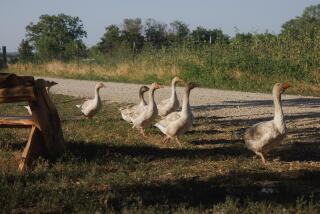Vermont Farm Project Planned for City Children Ruffles Local Feathers
- Share via
READING, Vt. — Spring Brook Farm is as pretty as any that ever graced a Vermont picture postcard.
The 100-year-old maples turn colors above near-perfect stone walls along the dirt road running by a freshly painted red barn. The air on a warm fall afternoon is heavy with the smell of freshly mowed hay.
Only the cows are missing--and the kids.
The farm will have both come spring, when 25 prize Jerseys arrive from North Carolina to help teach disadvantaged kids from P.S. 124 in Brooklyn that milk doesn’t come from a carton and that self-esteem can come from getting the milk from a cow.
While the cows may be welcome, the kids have been challenged by some neighbors who say this is no place to bring inner-city children. And for the Vermont Land Trust, the project has illuminated the trickier social dimensions of preserving Vermont’s landscapes.
It all started when Jim Hagedorn, part-time Woodstock resident and executive vice president of his family’s plant food company, Stern’s Miracle-Gro Products Inc., sought a rural experience for 50 poor black and Latino sixth-graders from the Park Slope neighborhood of Brooklyn.
The company is spending about $400,000 annually on tutoring and special education for the children and on counseling for their parents. If the children stick with the program, the company will pay for their college educations.
But Hagedorn wanted to do more. He envisioned a program similar to one in England which sends 1,500 urban children to each of three farms for a week.
Hagedorn settled on Spring Brook Farm, 641 acres that had been donated to the Vermont Land Trust in 1983 by Helen and John Mayer, gentlemen farmers who had operated the dairy farm for nearly 40 years.
The purpose of the trust is to preserve the farmland that has given Vermont its rural character. The group often buys development rights to land to ensure that it is not built upon; occasionally, it is given land, though the Mayer bequest is among the most generous to date.
Hagedorn would maintain the Spring Brook as a working farm. And his foundation offered $900,000 for the parcel. The trust accepted.
“Simply conserving land in the sense of imposing conservation restrictions is not our whole duty,” said Noel Fritzinger, chairman of the trust’s board.
The sale was not universally supported. Hagedorn attributes resistance to misunderstandings about the scope of the program and its impact on the community. He has promised to keep the nonprofit farm on tax rolls, keep the kids occupied, and maintain the farm as a show piece.
Still, “I don’t think that the fact that this is a minority program helps at all,” he admits.
A local newspaper called the objections “baffling” and said they detected an “ugly whiff of racism” at hearings on the proposal.
“Who are you to decide who my children play with?” one resident demanded, after asking whether Miracle-Gro kids would use the town pool or playground when Hagedorn considered an alternate property in neighboring Woodstock.
Willard Rhodes, a retired neighbor who spends winters in Florida, drives by the farm to reach his house, about a half-mile away.
He insists that he isn’t opposed to the children, but doesn’t think the project fits the neighborhood. Reading, with fewer than 700 residents, doesn’t have emergency services or playgrounds and other amenities for city kids, he says.
“There’s a time and place for children, and this is not the place,” he says. “There’s no playground for them.”
Helen Mayer is among the opponents. The day the foundation closed on the property, she offered $935,000 to buy it back.
And earlier, when Hagedorn was negotiating to buy the farm, Mayer refused to waive restrictions that prohibited residential use. So Hagedorn agreed to purchase an adjacent 45-acre parcel for a dormitory.
In an open letter, Mayer said she and her husband--since deceased--had intended that the farm be used to teach “individuals professionally interested in making farming a career or serious life interest.”
“Mr. Hagedorn’s program, while laudable in purpose, simply did not reflect the principal purpose that my late husband and I had expected to see realized, and had been led to believe would be realized, on the farm,” she wrote.
Her lawyer, Paul Lambert, says Mayer is considering her options in regard to the farm, but he would not say what they are.
In the meantime, work there goes forward--renovations have begun on the barn, a herdsman hired and designs for a dormitory started.
While the Miracle-Gro children will spend summers at the farm, other children and their teachers eventually will be invited for a week at a time, except in winter.
Farm managers William and Catherine Whitehouse can’t contain their enthusiasm.
“It seems like the whole world is all mixed up. . . . If we can show a kid they don’t have to live on welfare, just show them that it’s a different world out there . . . , “ says Catherine Whitehouse as she sits on a tractor with which she has been tedding the hay.
And some townspeople are supportive. “It’s a little annoying that a small, vocal minority is being touted as the mouthpiece of Reading,” said Gerard O’Doherty, a neighbor. “When you hear ‘we don’t want things to change’--goodness, they are changing all the time!”
Diane Rowlee, the Reading town treasurer, agrees.
“I think it’s time we shared some of the goodness we have up here with these children,” she says.
More to Read
Sign up for Essential California
The most important California stories and recommendations in your inbox every morning.
You may occasionally receive promotional content from the Los Angeles Times.













